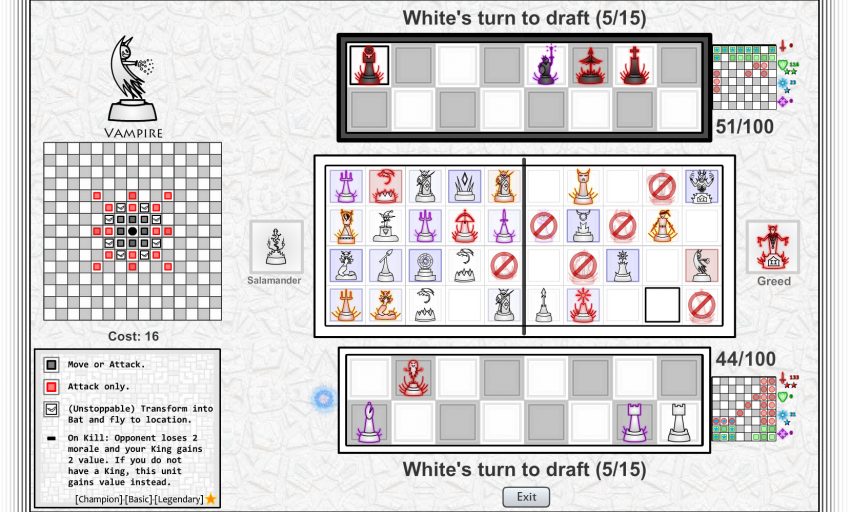For Chess Evolved Online players, this guide is about general army building concepts, things all armies need to take into account, counter, and should use or at least consider
Intro
This guide is about making a good army, and it assumes that you want to make an army that wins every single game. There will be no advocating for using some strategy which leads to rock-paper-scissors gameplay.
Piece Positioning
Pieces are stronger when they are closer to the centre, because in the centre, a piece may cover more squares (a bishop in the centre covers more squares on the board than a bishop on the edge). Pieces in the centre are also better because they can more quickly move to their ideal location (A knight in the centre can reach almost any square much faster than one in the corner).
This means two things
1. The centre slots in your army are in general better than those on the corners
2. Controlling the centre squares from the very start of the game is in general, good
You have to fill all 16 army slots, so the question is which pieces should be put in the less good corner squares, and which should we put in the superior central squares?
Diagonally moving pieces (like bishop) are good in the corner squares, because they control the centre immediately, and they can immediately develop towards the centre, which are the optimal squares.
Orthogonally moving pieces (like rook) are good in the central squares, because they control the centre immediately, and then can immediately develop towards the centre.
Very slow moving pieces (like haunted armour) are good in the centre, because they can go to either side of the board quickly.
Very slow moving pieces are bad in the corners because they will take forever to get to the action. Imagine a haunted armour in your left corner, and you want it on the right side of the board to help in your attack, well, it’ll never get there.
Fast moving pieces (such as valkyrie) are fine in the corners because they can immediately develop to a more central square. So the disadvantage of being far away from the action at the start is diminished.
The king is best placed in the corner, because you never want to develop the king, so the fact that the king can’t get anywhere fast is irrelevant. The fact that the king covers fewer squares is also irrelevant as you don’t want your king to be defending things.
The king is also best placed in the corner because it doesn’t block any of your own pieces, for example a king in the centre would block coverage of say, a pair of rooks on either side of it. You are never moving king forwards so the king will be in the way until you waste time castling or moving your rooks around it.
Let us apply this simple concept on the classic chess army to get a stronger army:

Bishops in corners, the king in the cornermost square (so it doesn’t interfere with any other pieces), the rooks/queens on the central files, and the knights are fine in the more corner squares since they can easily hop towards the centre.
For fun I plugged this army in to stockfish 13+NNUE vs the classic army at depth 25, and for white we have a +3 evaluation turn 1, and for black we have -1.6.
Avoid Excessive Homogeneity
Let us begin with an extreme example, here is a terrible army, as an exercise for the reader, figure out why it is terrible.

The army is terrible because all the pieces have the same coverage, in fact this army can be hard countered by a few pyromancers. So, it is very obvious to see where the problem is.
An army should have a diversity of coverage types, so that for any piece your opponent may have, you have a piece that can fight back against it effectively. Note that using 8 of the same minion and 4 of the same champion may not be a problem, so long as you have some diversity. You don’t need much diversity, just some. Here is an example of an army with little diversity, but enough.

4 knights for attacking at range 2, some angels for longer distance attacking, and samurai for short distance coverage. Even a ranger for some coverage that doesn’t require the piece to move when attacking. This army is balanced, despite using only a few types of pieces.
Note that this army follows the positioning rules outlined in the above section. Another reason for using a diverse set of pieces is because having only slow pieces makes it guaranteed that you have a slow piece stuck in the corner.
Minion Lines
There are some minions which cannot attack any enemy pieces, these minions should be avoided unless you have a very specific reason for using them. And no, “I want to bring out a piece quickly with portal” doesn’t count. You need a specific strategy/combo to justify using such pieces.
Here is an example of a bad army that doesn’t get enough use out of portal to justify using them

There are some minions which have very strong coverage, like fireball+, reaver++/pikemen++. Using 2 of those on the c/f minion slots is often very effective.

Doing this lets you instantly control the centre, and lets you keep away annoying enemy champions that may be developed early. This is a very solid option that you should consider when making a minion line.
Promoter minions such as princess/bat which cannot attack and are used solely for the hope that they can promote are terrible.
Minions that cannot move out of their lane (such as pawn) are generally better placed in the central minion slots, and not on the edges, as on the edges they cannot move towards the centre. So a pawn on the edge should be replaced by a militia or duelist or samurai etc which can move towards the centre.
Avoid Excessive Homogeneity the Sequel

This army has only expensive pieces, and you will just end up taking bad trades over and over as your opponent brings out their cheap minions firstMore generally, it is good to have some very cheap minions that you intend to push forwards first, and it is good to have some cheap champions that you intend to develop first to push back your opponent’s expensive champions.
Many armies would benefit from using 1 or 2 base mercenaries, as they are cheap and mobile, it is very likely your opponent will not be able to stop you from making a few good minion trades with them.
Is it wrong to use a full samurai line? Or a full frostmephit line? Nope, although against some armies you will have to accept a few bad trades, using a full line of very solid minions that cost 2 or 3 means you have no weaknesses or holes in your position whatsoever.
The Unstoppable Fork
I will show an army with a critical flaw, can you find it? If you are experienced probably, if you are new, I suggest not trying and just reading why the army is flawed.

a ninja could move out as follows and force a trade with the queen, or get checkmate
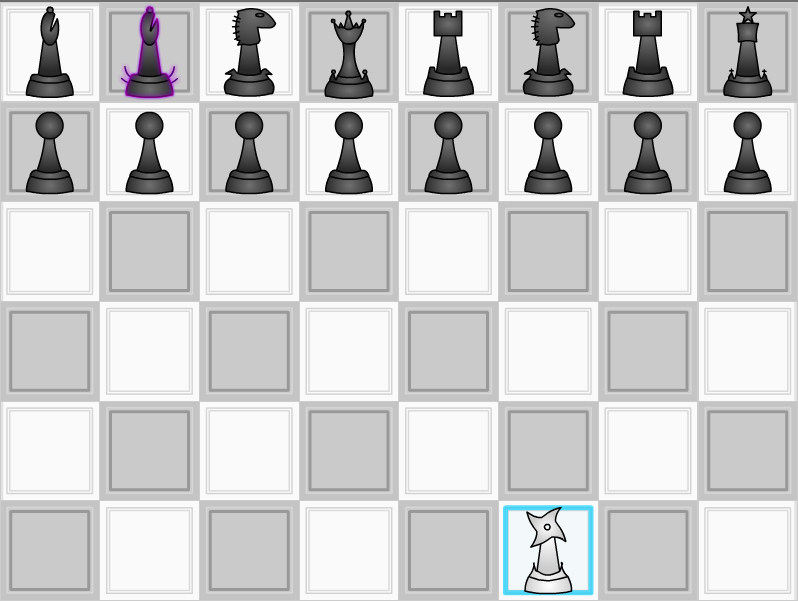
You can also do the same type of thing with an angel.
So when you are designing an army, make sure that no matter what square your opponent puts an angel/ninja on from turn 1, they can’t win any material.
You can do this either by using minions which cover the 4th rank, or by positioning your pieces cleverly apart from each other.
The Necessity of Magic/Ranged units
Consider an opponent who has curled into a ball, like so, how are you going to do anything to them with standard units?
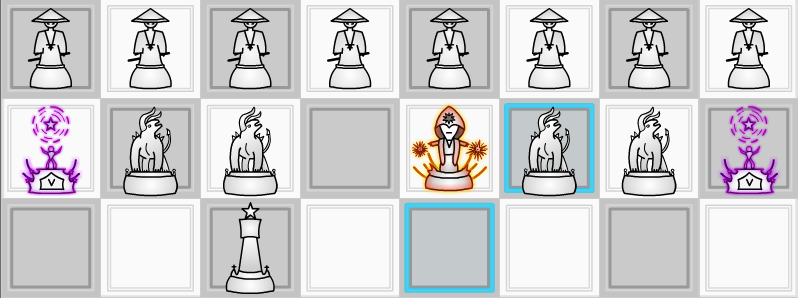
The answer is you probably aren’t, normal pieces can’t really touch such a defense, and you can imagine if your opponent tucked a gemini behind this formation to have more morale, they could probably wait you out until they won via morale decay. Maybe your army can push through somehow, but at some point, there will be an army which you can’t touch if you only use standard types of units, and you will lose.
So, enter magic/ranged pieces, one poison or magic/ranged destroy champion would let you tear through this formation. Even a piece like nullmage would let you null some pieces and win the stallfest.
Let us consider another type of ball-curling opponent
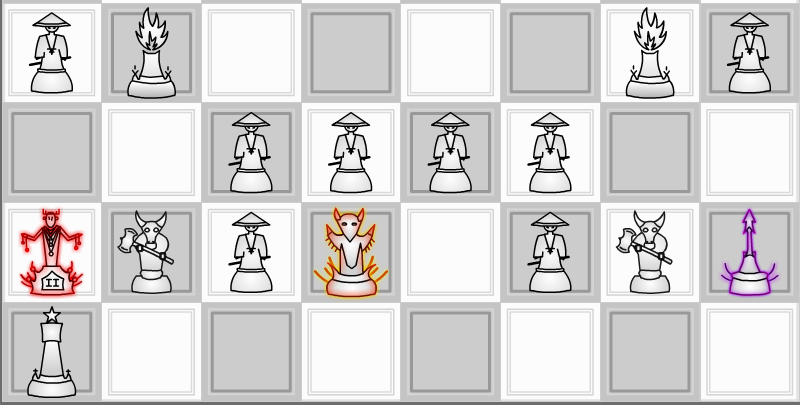
You cannot take the pyromancer with a champion, as otherwise minotaur would bring your king out to the centre of the board, where it will be captured by dragon++ pretty quickly. If you happen to run a minion which can capture pyro at range you would be fine (there are some other random counters too). But, if you have only very normal pieces and perhaps a line of pawns, you can do nothing. A single piece with some magic would let you displace the pyromancers and move forward.
There is one more type of ball curling involving lich+++, but anyways it is all the same, a magic piece would let you push through.
For this reason, running one magic or ranged piece is mandatory in all pretty much all armies. Ranger, voidmage, nullmage and poisonmage can all serve this purpose.
And because it is mandatory to run one such piece, it is mandatory that your army can counter any of those pieces effectively. If your army can’t effectively counter them, you can expect they will destroy some of your minions for free, and cruise to victory.
Countering Magic and Ranged
There are a handful of ways to counter ranged/magic pieces, I’ll just list a bunch of things
1. A piece like haunted armour is very effective at bullying ranger/fire-elemental/poisonmage away and even forcing trades into them
2. magic/ranged destroy units can support cheap minions that can push magic/ranged units away (be careful your minion can escape/force a trade in case the magic unit just backs up and targets it)
This is an example of failing to correctly use this concept, as the enemy ranger will just back up and win the samurai for free.
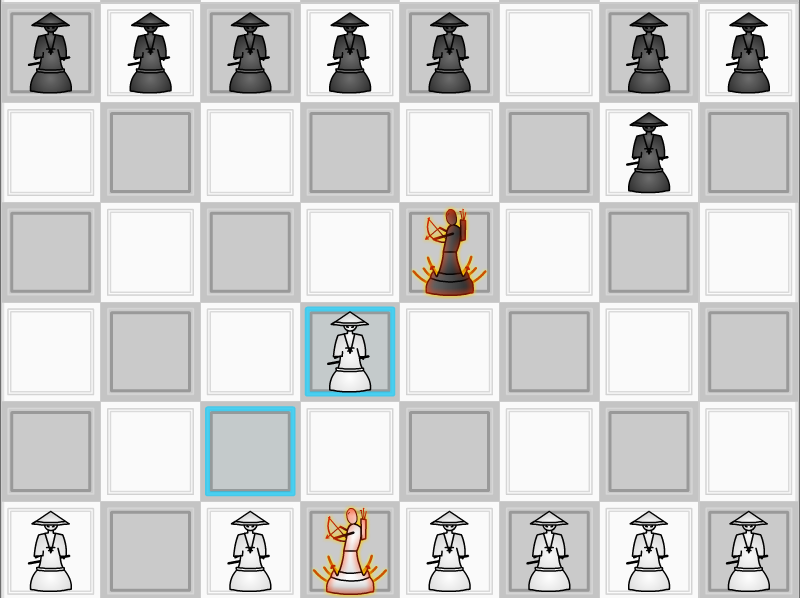 3. Minions with strong coverage like reaver++/pikeman++ are very effective at keeping away any type of ranged/magic unit
3. Minions with strong coverage like reaver++/pikeman++ are very effective at keeping away any type of ranged/magic unit
4. Just having champions that cover the board very effectively, and that cost less than 13 points is also effective, as most magic/ranged units are more expensive than 12. The cheap ranged/magic units are usually counterable without any specific planning.
5. Cheap champions with some medium range coverage, knight/envy can keep ranged/magic at bay
6. Running frostmephits as your minion line is a good counter, as the enemy magic/ranged units will get frozen if they try to touch the mephits, and the mephits can easily fall back and avoid the magic
if you want to counter these pieces with champions and not minions, you should have a solid plan for how you will develop your counter champions, otherwise your opponent may get some free kills on your minions before you get your counter in position.
Rush Armies and How they Warp the Meta
Imagine you an unsuspecting player, and suddenly you are facing this nonsense
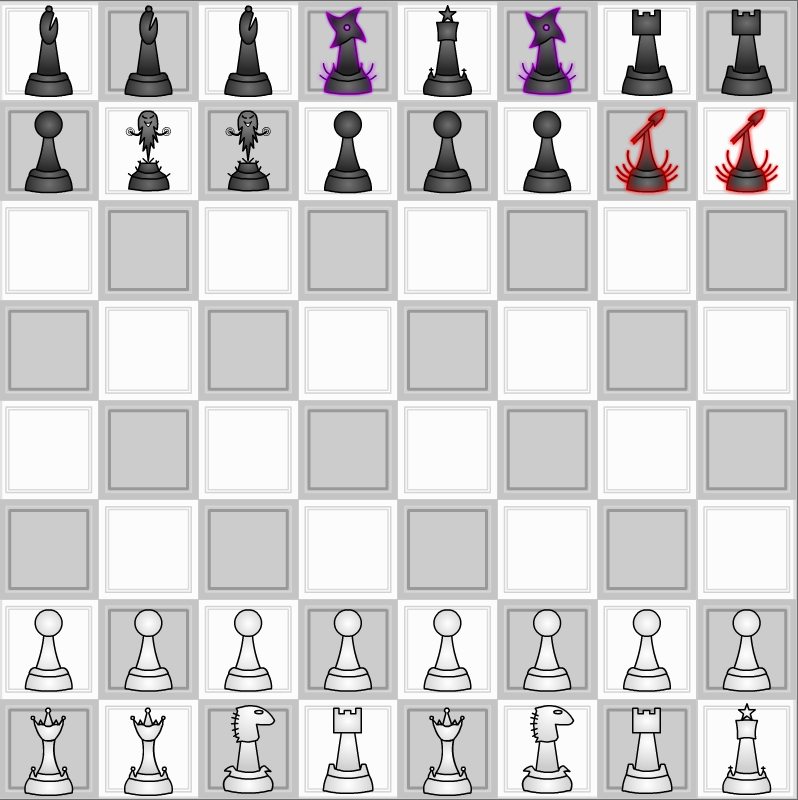
That is a lot of pieces aiming at your king, and you are gonna lose in no time.
There is also a hoplite rush which similarly would crush you.
So clearly the existence of rush armies has to be taken into account, if we just follow all the rules and things I’ve laid out until now, you can easily end up with an army that otherwise seems good, but gets smushed by a rush army.
The end result is that armies have to be more defensively oriented than offensively oriented, unless they want to get rushed.
Sometimes almost nobody runs rush in the meta, in this case you can get away with being greedy, so play it by ear.
Countering Rush and Making your Army More Defensive
Countering rush is mostly about just adding enough defensive strength to your army, here are some things you can do
1. Run a swapper that can get your king out of the corner, like paladin, even angel can be used to spend 2 turns to swap your king to the centre of the board out of the corner.
2. Put a phoenix next to your king, or whatever side is less well defended, phoenix is an incredibly strong defender, as evidenced by this position

the single phoenix is stopping all 3 of the pieces pointed at your king
3. Run pieces with king coverage near your corners, and pieces like angel/knight in the centre so they cover your minions on the edge. Put your king in the centre of the board. All this directly conflicts with my advice for how to optimally position pieces in the piece positioning section of this, but that is the trade-off.
4. Some magic units are exceptional on defense, necromancer/soulkeeper++ can completely shut down an attack almost by themselves, have an example:
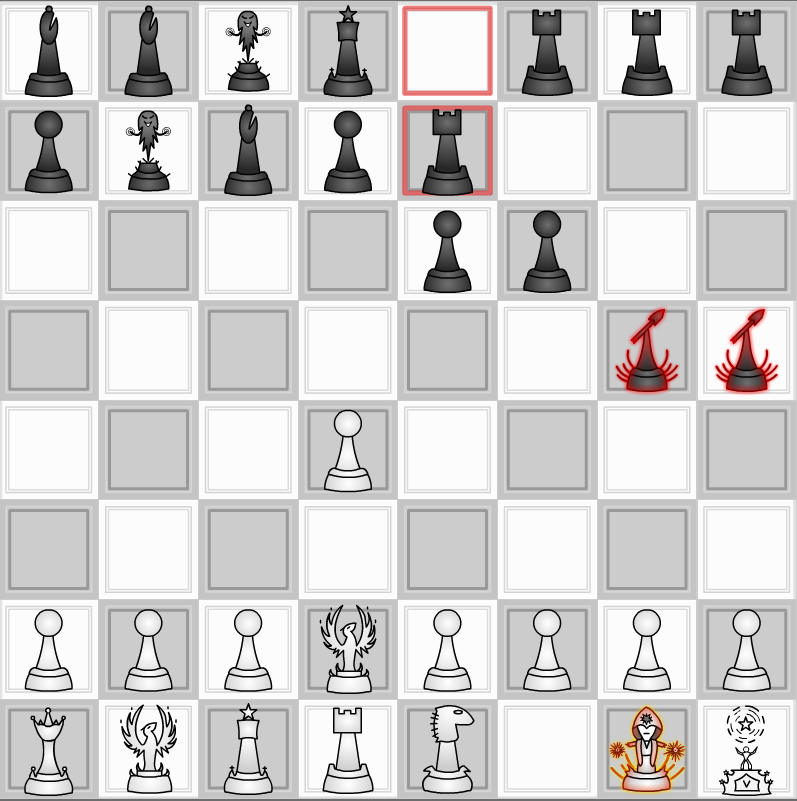
Despite like 20 pieces aimed at that corner, the soulkeeper means nothing can be done and you can easily bring over more pieces to help. Note that if the king was in the corner, you’d be doomed. Typically SK++ must be used in tandem with a swapper to get your king out.
5. Bomber+ is decent and can be placed in front of a bishop line or a rook line, and you don’t need to recapture when they attack into it, gaining a valuable turn, and every turn you get is a turn you can bring another piece closer to the defense.
6. Any magic destroy unit is also good on defense, though not as good as magic-transform. Here is a ranger++ doing a great job holding everything together.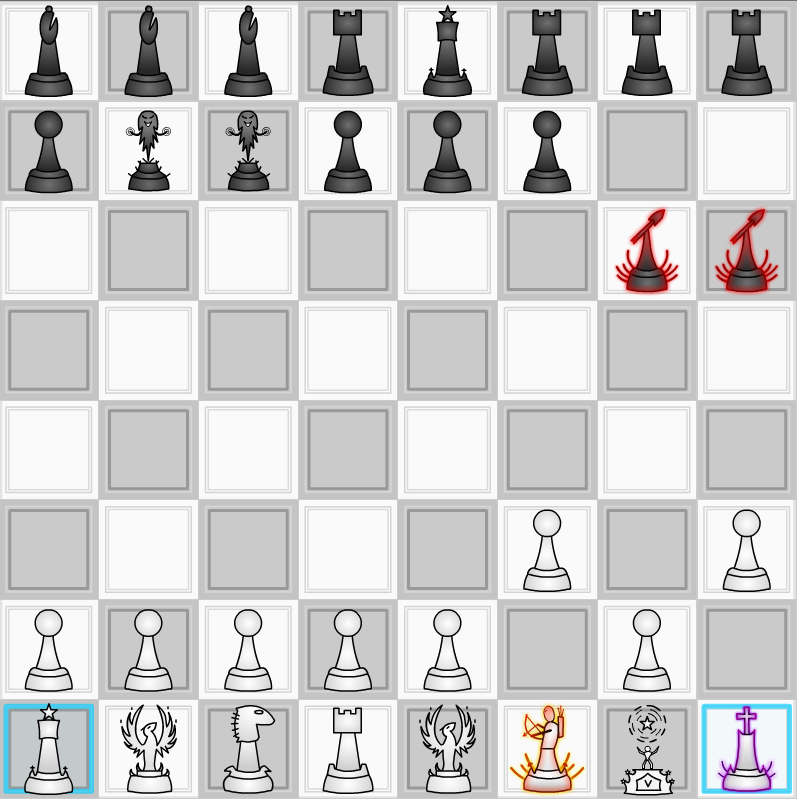
The ranger completely covers the key f3/h3 squares, and again makes trying to break through impossible without taking a huge number of bad trades.
Winning the Game of Morale
If you have followed everything up until this point when making an army, your army will not win by checkmate, most of the time, at least in high level games. Your army should be designed not to lose to rush, so it does numerous things that bring it in a defensive direction. Your army should also be designed to not lose to stall, so it runs some other slow magic/ranged units that allow it to slowly chip away at stall. The end result is there aren’t many pieces slots left to put towards an offensive goal.
So realistically the last few piece slots are going to be more defense, more magic, more counters to magic, and you are left with an army hopelessly incapable of checkmating.
So the win condition is letting your opponent’s morale hit 0 first. There are two ways to get this to happen.
The most obvious way is to get some good trades, and then get some more, and then eventually, in morale decay, your opponent will run out of morale first.
You can also run some pieces like pride/vampire/gemini/nullmage which are aimed at gaining morale advantage in exchange for using inefficient pieces. Go as heavy into this route as you can get away with. If you go too heavy your opponent will punish you by getting good trades and a better position.
The Power of Expensive Pieces
Since we are all about winning the game of morale in this guide, we should run at least one very expensive piece.
We intend to never lose this expensive piece (unless our opponent gives us a great trade), we will just hold on to it, and since it is expensive, it will take forever for us to lose in morale decay.
Furthermore, since it is so expensive, it will be very easy for us to get the final capture of the game. Once morale decay hits and your opponent is low on morale, you can start threatening to win the game by capturing just a single one of your opponent’s pieces. With our expensive piece with huge coverage, we will dance around the board threatening to win on every turn, until eventually we fork our opponent, or they get so low on morale we can just capture any old cheap piece.
I recommend using queen++ with some royalguard++s, or vampire+++, or angel+++, those are all very nice pieces with strong coverage that can fill the role of never dying and threatening to make the final capture in morale decay.
Avoiding That Which is Hard Countered
There are ideas in this game which get hard countered, since we are trying to win every single game, we generally should not use any of them.
No, magic units do not get hard countered by antimage.
Rush armies get hard countered.
Hoplite armies get hard countered.
Any army relying on minotaur gets hard countered.
Hostage armies get hard countered.
There are probably many more instances of things that can be hard countered, just try to be sure your army can beat any conceivable army, even if it was built specifically to try to counter you. (This is impossible but do your best)
